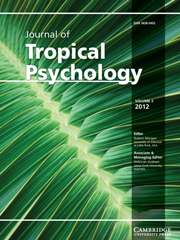Article contents
Strengths of character, orientations to happiness, life satisfaction and purpose in Singapore*
Published online by Cambridge University Press: 25 May 2015
Abstract
Positive psychology has identified six virtues comprising 24 character strengths of humans. This study examines the relationships among these character strengths, including Happiness, Life Purpose and Life Satisfaction as valued by Singapore Chinese, Malays, Indians and Other Asians and Caucasians. A sample of Singapore adults (N = 304) completed an online survey in English comprising four measures, the Values in Action Inventory of Strengths, the Orientations to Happiness Scale, the Satisfaction with Life Scale and the Life Engagement Test. Results show that Zest, Hope, Curiosity, Capacity to Love and Gratitude are the top five character strengths of the sampled Singaporeans. Happiness orientation through pursuing a Life of Meaning is preferred by all four ethnic groups. Ethnic differences are found for character strengths of Kindness, Humour, Gratitude, and Religiousness and Spirituality. Life of Meaning and Life of Engagement, Happiness orientations and character strengths of Curiosity and Perseverance are direct predictors of Life Purpose. In turn, Life Purpose and character strengths of Capacity to Love and Gratitude are found to be direct predictors of Life Satisfaction. Despite its other limitations, this study lays the groundwork for future studies using more robust sampling strategies and greater participation from the major ethnic groups in Singapore.
- Type
- Articles
- Information
- Copyright
- Copyright © The Author(s) 2015
Footnotes
This research was approved by the Human Research Ethics Committee and sponsored by James Cook University.
References
- 12
- Cited by




